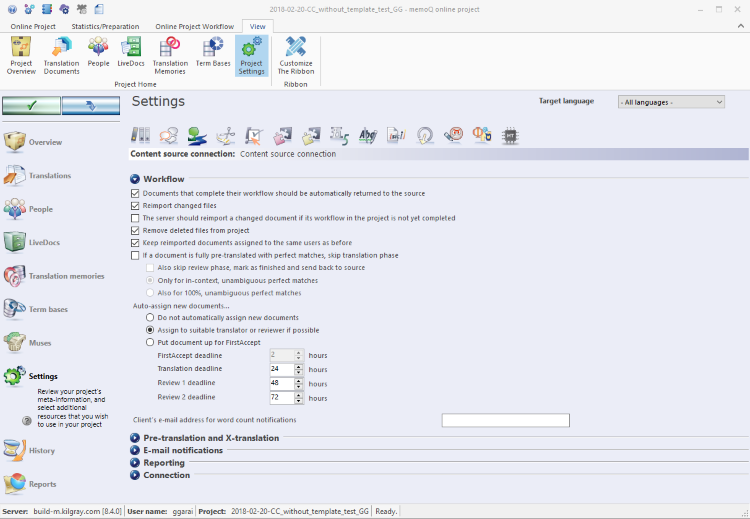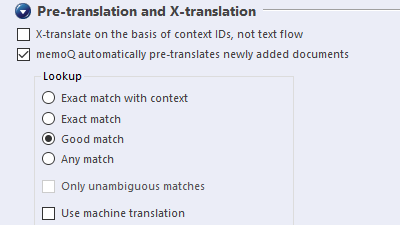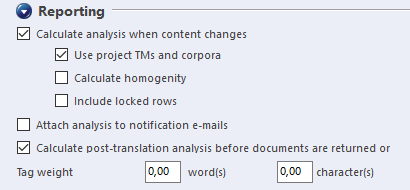memoQ online project - Settings - Content source connection
(for projects created without a template)
In a content-connected online project, memoQ server picks up new and changed documents from a content connector.
On the Content source connection tab, you can choose what happens when there is a change in the content source.
Use project templates whenever possible: Although we understand that content-connected projects may have a very long lifetime, we strongly encourage you to set up a new online project from a project template. This way you can set up a wide range of automated actions (for example, analysis or pre-translation) on the documents. In addition, you can tie these actions to various events in the project – which allows more accurate timing. To learn more: See Help about editing project templates.
How to get here
- On the project management dashboard, locate the project you need to manage. Search for the project if necessary.
- Click the name of the project.
- On the Project ribbon, click Manage. A new memoQ online project window opens. In most cases, the Translations pane appears automatically. Then, choose Settings:
- On the left, click the Settings icon. The Settings pane appears, with the General tab.
- Click the Content source connection icon. It looks like this:

The Content source connection tab appears.

What can you do?
For this, use the settings under Workflow:

- Documents that complete their workflow should be automatically returned to the source: If you check this check box, memoQ server automatically returns the translation to the content source when all of a document's assigned tasks are finished. This means, for example, that when Reviewer 2 confirms all segments, the document is returned, and the project manager cannot look at the document before final delivery. The check box is checked by default.
- Reimport changed files: Normally, memoQ server reimports the changed files from the content source. If you do not want to reimport the changed files, clear this check box.
- The server should reimport a changed document if its workflow in the project is not yet completed: Normally, memoQ server always reimports a changed document. However, if you do not want memoQ server to reimport documents that are still being translated or reviewed, clear this check box.
- Keep reimported documents assigned to the same users as before: If you check this check box, you do not have to assign the documents again to users when are re-imported, if something changes in the content source.
- Remove deleted files from project: Normally, if a file is deleted from the content source, memoQ server also removes it from the project. If you want to keep those documents that were deleted from the content source, clear this check box.
- If a document is fully pre-translated with perfect matches, skip translation phase section:
- To skip the review phase, too: Check the Also skip review phase, mark as finished and send back to source check box.
Example: a document is re-imported and pre-translated, and all its segments have single (unambiguous) 100% or 101% matches. What memoQ server does with that document depends on the setting you choose: - Only for in-context, unambiguous perfect matches: memoQ server sends the document for review because it contains segments with 100% matches, too. If it contained only 101% matches, memoQ server would send it back to the content source.
- Also for 100%, unambiguous perfect matches: memoQ server sends the document back to the content source.
- To skip the review phase, too: Check the Also skip review phase, mark as finished and send back to source check box.
- Auto-assign new documents section: Choose one of these 3 radio buttons:
- Do not automatically assign new documents: memoQ server does not assign new documents automatically to users in the project.
- Assign to suitable translator or reviewer if possible: memoQ server assigns new documents to translators and reviewers. Set roles for users in the People > Languages and roles tab.
- Put document up for FirstAccept: memoQ server offers the document for FirstAccept: invited users can check out a local copy of the project; open the document in read-only mode; and then they can decide if they accept the document for translation or review. Choose a deadline in the FirstAccept deadline drop-down. Default deadline is 2 hours. Set the deadlines for the translator, reviewer 1 and reviewer 2.
- Client's e-mail address for word count notifications: In this box, enter the email address of the client's contact. If you write an email address here, memoQ server will send emails whenever new or changed documents are imported. These emails include the word count for the changes. You can also enter this email address when you create the project.
Define the pre-translation and x-translation settings for your documents in the Pre-translation and X-translation section:

- To make X-translate look at the context IDs of segments, not their text content: Check the X-translate on the basis of context IDs, not text flow check box.
- To have memoQ server pre-translate new documents and X-translate updated document automatically after import or re-import: Check the memoQ automatically pre-translates newly added documents: This check box is checked by default.
Note: Make sure you assign translation memories or LiveDocs corpora to the project before new documents are added and pre-translated.
Use the settings in the Lookup section to control pre-translation:
- In the Lookup section, choose the minimum match type for pre-translation. You can choose from Any match, Good match, Exact match, and Exact match with context. If you use Exact match or Exact match with context, and check the Only unambiguous matches check box – so that memoQ does not pre-translate segments that have two or more matches with the same match rate.
- Use machine translation: If you check this check box, memoQ offers suggestions from MT plugins, and also suggestions put together from partial TM or term base matches.
memoQ server sends emails to project managers when there is a change in the content source. Using the settings under E-mail notifications, you can choose the events about which memoQ server sends emails:

If you cannot see the check boxes, click the E-mail notifications heading. Normally, memoQ server sends emails about all the listed events - to users who have email addresses set up in their user accounts.
If you do not want memoQ server to send emails about certain events, clear the check box of the event.
To set up an email address for a user: Open Server Administrator. Choose Users. Select the user. Below the list, click Edit. The User properties window opens. Enter the email address, then click OK. Note: If the user account comes from a corporate network, you will not be able to enter the email address here.
- Notify project manager when content is added, changed or removed from the project: memoQ server sends an email to the project manager every time the project is updated from a change in the content source. If there is a change in the content source, but the project is not updated, the server does not send an email.
- Notify project manager if auto-assignment of new content is unsuccessful: memoQ server sends an email to the project manager if it cannot automatically assign all new documents to users.
- Notify project manager if the server's attempt to poll the content source fails: memoQ server sends an email to the project manager if it cannot reach the content source. Do not clear this check box.
- Notify project manager if the project is not updated with content changes because the workflow of a changed document is not yet completed: memoQ server sends an email if a document is changed but its workflow is not yet completed, and the server is configured not to update the project if a documents is still being translated or reviewed.
- Notify project manager if the content connection is deleted or the project is severed: memoQ server sends an email to the project manager if the content connection is no longer available. This can happen when the connection is deleted from the content connector service, or when memoQ server is unable to connect to the content source for several times - or, when the content source actively refuses the connection. Do not clear this check box.
- Notify participants when existing content changes: memoQ server sends an email to all participants when the project is updated from the content source. This means that the server sends an email when a new document is imported, a changed document is re-imported, or when a deleted document is removed from the project.
In the Reporting section, you can tell memoQ server when to create analysis reports:

By default, memoQ server creates a new analysis report when new documents are added to the project, or when existing documents are updated. When a document is returned to the content source or removed, memoQ server creates a new post-translation analysis report. Use the options in this section to turn these activities on or off.
To create a new analysis report each time a document is added or updated in the content source: Check the Calculate analysis when content changes check box. It is checked by default. The options are the same as on the memoQ online project> Overview > Reports tab.
- To analyze the new content against the translation memories and LiveDocs corpora in the project: Check the Use project TMs and corpora check box. It is checked by default.
-
To analyze internal fuzzy matches in the project - that is, the fuzzy matches from your own work until now: Check the Calculate homogeneity check box. It is cleared by default.
When memoQ calculates statistics with homogeneity, it uses the tag strictness ("Inline tag strictness for exact matches") settings from the TM settings of the project.Do not use homogeneity when more than one translator works on a project: Because you cannot tell which segments will be translated first, the statistics will be inaccurate. For more details, see Help about homogeneity and repetitions in a project.
- To calculate the analysis also for locked rows: Check the Include locked rows check box. It is unchecked by default: normally, locked rows are not counted in analysis reports.
- To send analysis reports in emails after automatic or FirstAccept assignment: Check the Attach analysis to notification e-mails check box. You can do that only when the Calculate analysis when content changes check box is checked.
- To create a new post-translation analysis report when a document is finished (and sent to the content source), or when a document is deleted from the content source (and removed from the project): Check the Calculate post-translation analysis before documents are returned or removed check box. Just like in the Overview pane, you can tell how to count formatting and inline tags using the Tag weight boxes.
The Connection section shows the Connection name, Description, the URL, and the Polling frequency of the connection:

If you cannot see these details, click the Connection heading.
The Polling frequency (hours) box shows how often memoQ server checks the content source for changes. memoQ server can do this every few hours, and this box contains the number of hours. You can change this setting. Normally, the Polling frequency (hours) spin box contains the value that was entered when the project was created.
When you finish
On the Settings pane, choose another tab. Or, choose another pane in the memoQ online project window.
If you make changes to any of the settings, don't forget to save them.
When you make changes to an online project, the changes will happen on memoQ server, not on your computer. It is possible that several users make changes to the project at the same time.
Some changes are not saved automatically. When there are changes you need to save, the green tick mark icon at the top left will become orange:
![]()
To save changes to the online project, click this button.
To get the changes that others made to the online project, click this button:
![]()
Make sure you save your changes before you click this.
Switch windows: You can open several online projects for management. Each online project opens in a separate window. To switch between them and the Dashboard or Project home (if you have a local project open): press and hold down Alt, and press Tab a few times until you get to the window you want. Or: On the Windows taskbar, click the memoQ icon, and then click the window you want to switch to.